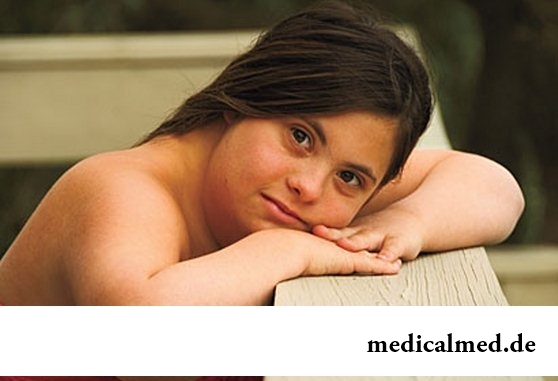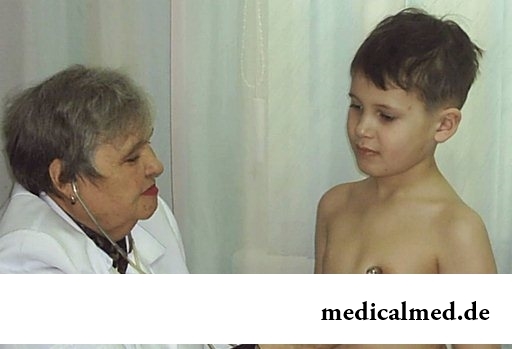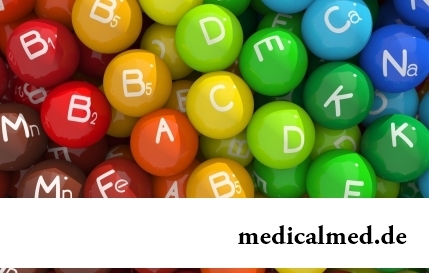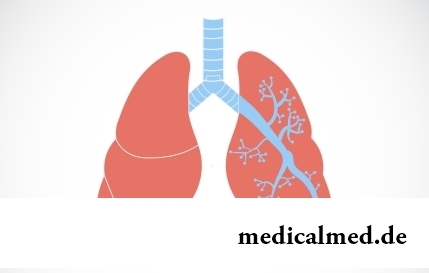





Oligophrenia
General characteristic of a disease

The oligophrenia is the inborn or acquired at early age weak-mindedness. It is expressed in the general underdevelopment of mentality and first of all affects intelligence of the person. The term "oligophrenia" comes from two Greek words "oligos" (small) and "phrzn" (reason) though expressions "a mental delay" or "mental insufficiency" are considered as more correct. In use to mental retardation at children quite often call mental backwardness, and the child with a delay of intellectual development - backward.
The oligophrenia as individual disease, was classified only at the beginning of the last century. Till this time the general umbrella term "weak-mindedness" combined patients both with an inborn disease, and with the acquired mental underdevelopment, for example, senile dementia.
Oligophrenia reasons
There are three groups of the factors provoking development of a disease:
The first complex of the reasons of an oligophrenia has endogenous (internal) character. Here carry all types of the mental underdevelopment caused by chromosomal pathologies, various genetic syndromes and hereditary specific disbolism. Can serve as the reason of an oligophrenia of this type Klaynfelter, Shereshevsky-Turner, Rubinstayn's syndrome — Teybi, a Down syndrome, different types of a mukopolisakharidoz and other metabolic diseases.
The second complex of the reasons of an oligophrenia make factors exogenous, i.e. external, etiologies. In this case pre-natal infections can cause the general mental underdevelopment in the patient during pregnancy, the immunoconflict of blood of mother and child, birth and puerperal trauma of a skull of the kid, alcoholism of mother, drug addiction and other addictions which provoked serious violations in supply of a fruit with nutrients.
The complex of the reasons of an oligophrenia of the mixed etiology consists of factors of both the exogenous, and endogenous nature. As a result of cumulative impact on a human body at once of several adverse factors the most severe forms of an oligophrenia develop.
Oligophrenia forms
To each complex of the reasons of an oligophrenia there corresponds the separate form of a disease. In total for today it is accepted to distinguish 4 forms of an oligophrenia:
The I form of an oligophrenia – the hereditary option of a disease caused by defective generative cells of parents of the patient. Carry patients with a Down syndrome, a nanocephalia and a mental underdevelopment against the background of serious pathologies of skin and bones of the person to the I form of an oligophrenia.
The II form of an oligophrenia – different types embrio-and fetopathies. Rank the types of a mental underdevelopment caused by pre-natal factors as the II form of an oligophrenia: viral, bacterial or parasitic infections of the woman during pregnancy, hemolitic diseases of a fruit.
The III form of an oligophrenia – the delay of mental development in the child provoked by a birth trauma, a hypoxia or asphyxia at the time of delivery and also the encephalitis postponed aged up to 3 years, meningitis or a serious craniocereberal injury.
And the last VI form of an oligophrenia – the type of a mental underdevelopment caused by progressing of the basic inborn disease, for example, of various defects of a brain or endocrine pathologies.
Oligophrenia degrees
Depending on expressiveness of intellectual defect and intelligence quotient of the patient distinguish 3 degrees of an oligophrenia:
It is accepted to call easy mental retardation moronity. At patients with this degree of an oligophrenia the intelligence quotient is in repartitions of 50-70 balls. Patients have quite developed speech, can make simple arithmetic operations (to put, take away, count money). Their focus of interest is limited by household questions. To training patients with easy degree of an oligophrenia of interest do not show and show full inability to abstract thinking. They are able to acquire rules of public behavior and skills of primitive monotonous manual skills.
Deficiency of intellect – oligophrenia degree with moderate expressiveness of an intellectual underdevelopment. Intelligence quotient of these people from 20 to 49 points. Patients with this degree of an oligophrenia are tongue-tied. Their lexicon consists of several tens words. At this degree of an oligophrenia at the person ability to self-service remains, but to perform the most primitive production work as the patient often is not able.
Idiocy – oligophrenia degree with the deepest mental retardation. Patients of this group have intelligence quotient less than 20 points. The thinking at deep degree of an oligophrenia is almost undeveloped. Patients badly understand the speech turned to them. Their communication with people around is limited to manifestation of emotions of pleasure or displeasure. Skills of self-service at patients are absent, and they are completely dependent on the people who are looking after them.
Diagnosis of an oligophrenia
Some forms of an oligophrenia caused by genetic factors can be diagnosed at a stage of pre-natal development today. The issue of a possibility of abortion is in that case resolved.
The oligophrenia is diagnosed for children of the first year of life on the basis of the whole complex of symptoms of physical and mental lag in development. The oligophrenia at children of the earliest age is expressed in inability of the child about one year to hold the head, to sit, fix a look on one point, to turn the head on a sound, to smile or babble on the speech turned to it.
The oligophrenia at children of the second year of life is shown in lack of desire to learn the environment, in backwardness of the speech and motility. The child does not understand the speech turned to him and does not try to imitate actions of adults. At the earliest age the heaviest degrees of an oligophrenia are diagnosed, as a rule.
In the preschool period easy degree of an oligophrenia at children is expressed in poorly developed speech, dominance of primitive emotions, bad learnability and inability to self-service.
Treatment of an oligophrenia

For identification of various forms of an oligophrenia children around the world have a patronage control system of physical and mental development of the child from the birth and before its definition in school. Unfortunately, treatment of a disease is possible only at children with an oligophrenia of a metabolic etiology. In that case to the child drugs for correction of a metabolism are appointed, and the further course of a disease depends on a susceptibility of a children's organism to treatment.
At all other forms of an oligophrenia at children it is possible to carry out only auxiliary therapy by vitamin complexes, amino acids, nootropa, drugs for stimulation of cerebral circulation and reduction of intracranial pressure.
The diagnosis of "mental retardation" at children assumes participation of the child in the social program of rehabilitation. At easy and average degree of an oligophrenia patients go to specialized kindergartens and boarding schools. There they get an education approximately at the level of 4 classes of usual school and at the same time study any profession. After the termination of a nursing home most of graduates finds a job. At all forms of an oligophrenia to patients disability is made out and the allowance is granted.
When lovers kiss, each of them loses 6,4 calories a minute, but at the same time they exchange nearly 300 species of various bacteria.

The immunity role in growth of the child is invaluable. The proteins-immunoglobulins produced by immune system preserve the child against diseases...
Section: Articles about health
Coffee – favourite drink of many. For the last decades it more than once already declared very harmful, extremely useful and even necessary for normal life activity. In spite of the fact that this product became for us usual for a long time, exists much...
Section: Articles about health
(Xerostomia) many people consider feeling of a xerostomia small and easily removable inconvenience. This delusion: the symptom can demonstrate existence of serious diseases. It is worth to remember also that saliva performs important functions in an organism: clears the surface of teeth of a food plaque, growth of pathogenic microorganisms oppresses, normalizes acid-base balance, liquefies food and helps to split the carbohydrates which are contained in it. Chronic deficit слюн...
Section: Articles about health
Vitamin complexes belong to the most popular drugs, probably, in our country there is no person who was not hearing about a floor...
Section: Articles about health
The trophic ulcer is not an independent disease. This heavy complication arising owing to a thermal injury (a burn or a frostbite), chronic pathologies of arteries or veins of the lower extremities, a diabetes mellitus, and also some defeats of a soyeda...
Section: Articles about health
They say that to ensure health and longevity of people it is obliged. Really, at competent approach to these questions, minimization of an adverse effect of many factors does not represent a special problem. Practically everyone has an opportunity to play sports, to pick up an optimum operating mode and rest, to adjust healthy food, to refuse addictions. It is more difficult to exclude hit in an organism of harmful substances through a respiratory organs: not all are able to afford to live in the area with хо...
Section: Articles about health
It would seem, to buy drugs in Moscow does not make a problem – a drugstore, and not one, is available for each resident of the capital in step a toast...
Section: Articles about health
The hysteromyoma is diagnosed more than at a third of women 35 years are more senior. This high-quality new growth which at early stages successfully resolves by means of medicines. It is necessary to resort to an operative measure only in those a case...
Section: Articles about health
Each woman has preferences in the field of use of those goods which help us to look good, feel young and effective. Besides: selection process of favourite perfume, shampoo or decorative cosmetics already lightens the mood and serves as a peculiar stress medicine. Happens very offensively when the acquired perfumery and cosmetic products not only do not meet our expectations, but also becomes the reason of problems with health. Sources неприятн...
Section: Articles about health
Tuberculosis – a serious infectious disease which development is caused by mycobacteria (Koch's bacilli). The illness is known from a deep d...
Section: Articles about health
One of the major chemical processes happening in a human body are oxidation reactions. They go with participation of fats and carbohydrates which we receive from food, and the oxygen getting to us from air. A main goal of such reactions is it is received...
Section: Articles about health
Tick-borne encephalitis – one of the most dangerous viral diseases which causative agents transfer and is given to people by ixodic mites. These are the small blood-sicking insects living in the considerable territory of our country. The person bitten by a tick can catch also erlikhiozy, bartonnelezy, babeziozy, mycoplasmosis and Lyme's disease. As well as encephalitis, these illnesses affect the central nervous system, and as specific antiviral therapy does not exist, the forecast very to a neuta...
Section: Articles about health
It is impossible to imagine human life in which there would be no plants. Practically in each apartment and any of productions...
Section: Articles about health
The pancreas performs two functions in a human body: release of enzymes without which digestion of carbohydrates, fats and proteins, and a producing hormones is impossible. The most important of them - insulin, is the main participant of carbohydrate metabolism, a normal...
Section: Articles about health
The advantage of swimming for the person is so high that this sport is not only the most popular, but also is widely applied in medicine and rehabilitation processes. If you look for for yourself the occupation allowing pleasantly and to spend time, then swimming with advantage – the fact that it is necessary for you. And give learns several facts about swimming....
Section: Slideshow
Small appetite at the child – the complaint which pediatricians should hear practically from each mother. Most often it is carried to разр...
Section: Articles about health
Aging — natural and inevitable process. Over time our skin loses elasticity, on it saggings are formed, the face form loses former clearness. The procedure of nitevy lifting (nitevy tightening) can successfully solve this problem. In order that it is better познако...
Section: Articles about health
Doctors claim that the people not so familiar with a dorsodynia occur among adult Russians very seldom. At the same time the vast majority of the patients who are periodically testing this indisposition do not hurry to ask for medical care at all. On the one hand, there is an opinion that feelings of this sort at mature age are nearly natural phenomenon which is not doing serious harm to health. With another – practice of self-treatment various obezbol is eurysynusic...
Section: Articles about health
Cystitis, or inflammation of a mucous membrane of a bladder, this very widespread disease, which, owing to some persons...
Section: Articles about health
Many of us, probably, noticed more than once that from intellectual loadings at some point the brain as though "overheats" and "assimilation" of information is strongly slowed down. Especially this problem urgent for persons of age becomes more senior than fifty years. "It is already bad with...
Section: Articles about health
Tea is loved and use almost everything. This drink has tonic properties, contains the tannins capable to suppress activity of causative organisms. Recently great popularity was gained by teas with vegetable additives. The medicative herbs, spices and fruit which are a part of such mixes enrich drink with vitamins and microelements, increasing its nutritional value and creating additional curative effect....
Section: Articles about health
History of cultivation of a buckwheat contains more than five thousand years. Grain which is received from this plant is used for пригото...
Section: Articles about health
Work of a brain is extremely complex and in many respects is not studied yet. It is confirmed also by the features of thought processes which are shown when the person sleeps. Let's tell about some of them....
Section: Articles about health
For the person who daily since morning gathers for work it is very important to wake up vigorous and ready by day of work. Actually, each of us experiences difficulties with this, at first sight, simple business from time to time. After night rest exert impact on a condition of an organism the weather which collected for several days fatigue, household and office problems, quality of a dream and many other factors....
Section: Articles about health
The list of stereotypes of which, apparently, all know strongly includes following: British surely eat for breakfast овсянк...
Section: Articles about health
Sometimes it seems that modern society was divided into two camps: representatives of the first are sure that only the woman has to be responsible for contraception, representatives of the second, respectively, are sure that it is destiny of men. Meanwhile Dov has a question of contraception...
Section: Articles about health
Run - one of the most available and effective ways to revitalize the organism. Knowing about its extraordinary advantage, each of us at least once tried to make jogs, but only the few made these occupations regular. In spite of the fact that in jogging (easy jogging), apparently, there is nothing difficult, the beginning runners often make mistakes which lead to complete cessation of trainings. Let's consider 10 useful tips for beginners who will allow them to make regular п...
Section: Articles about health
